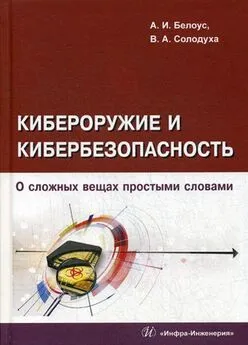А. Белоус - Кибероружие и кибербезопасность. О сложных вещах простыми словами
- Название:Кибероружие и кибербезопасность. О сложных вещах простыми словами
- Автор:
- Жанр:
- Издательство:Инфра-Инженерия
- Год:2020
- ISBN:978-5-9729-0486-0
- Рейтинг:
- Избранное:Добавить в избранное
-
Отзывы:
-
Ваша оценка:
А. Белоус - Кибероружие и кибербезопасность. О сложных вещах простыми словами краткое содержание
Для технических специалистов в области микроэлектроники, информационных технологии и безопасности. Также книга будет полезна преподавателям вузов, студентам, изучающим информационные технологии.
Кибероружие и кибербезопасность. О сложных вещах простыми словами - читать онлайн бесплатно ознакомительный отрывок
Интервал:
Закладка:
Затем спецслужбам остается только нанести «правильную» маркировку на корпус и реализовать операцию замены закупаемой оригинальной микросхемы на «заряженную», используя стандартные методы из своих обширных арсеналов, или «работая» с сотрудниками фирмы-победителя конкурсов на закупку импортной ЭКБ (публикуются в открытой печати), или даже без их ведома осуществить замену.
Литература к разделу 7.9
1. К. Сяо, Д. Форте, И. Цзинь, Р. Карри, С. Бхуниа, М. Техрани-пур. 2016. Аппаратные трояны: Выводы по результатам десяти лет исследований АСМ Trans. Des. Autom. Electron. Syst. 22, 1, Статья 6 (Май 2016), 23 страницы. DOI: http://dx.doi. org/10.1145/2906147 Формат источника (АСМ).
2. J. Aarestad, D. Acharyya, R. Rad, and J. Plusquellic. 2010. Detecting Trojans through leakage current analysis using multiple supply pad IDDQ. IEEE Transactions on Information Forensics and Security 5, 4 (Dec. 2010), 893–904. DOI: http://dx.doi. org/10.1109/TIFS.2010.2061228.
3. S. Adee. 2008. The hunt for the kill switch. IEEE Spectrum 45, 5 (May 2008), 34–39. DOI: http://dx.doi.org/ 10.1109/ MSPEC.2008.4505310.
4. D. Agrawal, S. Baktir, D. Karakoyunlu, P. Rohatgi, and B. Sunar. 2007. Trojan detection using IC fin- gerprinting. In Proceedings of the IEEE Symposium on Security and Privacy, 2007 (SP’07). 296–310. DOI: http://dx.doi.org/10.1109/SP.2007.36.
5. M. Banga and M. S. Hsiao. 2009. A novel sustained vector technique for the detection of hard- ware Trojans. In Proceedings of the 2009 22nd International Conference on VLSI Design. 327–332. DOI: http://dx.doi.org/10.1109/VLSI.Design.2009.22.
6. C. Bao, D. Forte, and A. Srivastava. 2014. On application of one-class SVM to reverse engineering-based hard- ware Trojan detection. In Proceedings of the 2014 15th International Symposium on Quality Electronic Design (ISQED’14). 47–54. DOI: http://dx.doi.org/10.1109/ISQED.2014.6783305.
7. A. Baumgarten, A. Tyagi, and J. Zambreno. 2010. Preventing IC piracy using reconfigurable logic barriers.
8. M. Beaumont, B. Hopkins, and T. Newby. 2012. SAFER PATH: Security architecture using fragmented execution and replication for protection against Trojaned hardware. In Proceedings of the Design, Automation Test in Europe Conference Exhibition (DATE’12). 1000 1005. DOI: http://dx.doi.org/10. 1109/DATE. 2012.6176642.
9. S. Bhunia, M. S. Hsiao, M. Banga, and S. Narasimhan. 2014. Hardware Trojan attacks: Threat analysis and countermeasures. Proceedings of the IEEE 102, 8 (Aug. 2014), 1229–1247. DOI: http://dx.doi.org/10.1109/JPROC.2014.2334493.
10. Y. Bi, P.-E. Gaillardon, X. S. Hu, M. Niemier, J.-S. Yuan, and Y. Jin. 2014. Leveraging emerging technology for hardware security — case study on silicon nanowire FETs and graphene SymFETs. In Proceedings of the 2014 IEEE 23rd Asian Test Symposium (ATS’14). 342–347. DOI: http://dx.doi.org/10.1109/ATS.2014.69.
11. G. Bloom, B. Narahari, and R. Simha. 2009. OS support for detecting Trojan circuit attacks. In Proceedings of the IEEE International Workshop on Hardware-Oriented Security and Trust, 2009 (HOST’09). 100–103. DOI: http://dx.doi.org/10.1109/HST.2009.5224959.
12. Cadence. 2011. 3D ICs with TSVs — design challenges and requirements. Retrieved from http://www. europractice.stfc. ac.uk/vendors/cadence_3DIC_wp.pdf.
13. Y. Cao, C.-H. Chang, and S. Chen. 2013. Cluster-based distributed active current timer for hardware Trojan detection. In Proceedings of the 2013 IEEE International Symposium on Circuits and Systems (ISCAS’13). 1010–1013. DOI: http://dx.doi.org/10.1109/ISCAS.2013.6572020.
14. B. Cha and S. K. Gupta. 2012. Efficient Trojan detection via calibration of process variations. In Proceedings of the 2012 IEEE 21st Asian Test Symposium (ATS’12). 355–361. DOkhttp:// dx.doi.org/ 10.1109/ATS.2012.64.
15. B. Cha and S. K. Gupta. 2014. A resizing method to minimize effects of hardware Trojans. In Proceedings of the 2014 IEEE 23rd Asian Test Symposium (ATS’14). 192–199. DOkhttp:// dx.doi.org/10.1109/ATS.2014.44.
16. R. S. Chakraborty and S. Bhunia. 2009. Security against hardware Trojan through a novel application of design obfuscation. In Proceedings of the IEEE/АСМ International Conference on Computer-Aided Design — Digest of Technical Papers, 2009 (ICCAD’09). 113–116.
17. R. S. Chakraborty, F. Wolff, S. Paul, C. Papachristou, and S. Bhunia. 2009. MERO: A statistical approach for hardware Trojan detection. In Proceedings of the 11th International Workshop on Cryptographic Hardware and Embedded Systems (CHES’09). Springer-Verlag, Berlin, 396–410. DOLhttp:// dx.doi.org/ 10.1007/978-3-642-04138-9 28.
18. A. Chidley. 2014. Use COTS parts to cut costs in military and aerospace systems. Electronic Design Magazine Retrieved from http://electronicdesign.com/components/use-cots-parts-cut-costs-military-and-aerospace-systems.
19. Cisco. 2005. Defense agencies meet readiness challenges with commercial off the shelf (COTS)-based systems. Retrieved from http://www.cisco.eom/c/dam/en_us/solutions/industries/docs/gov/space_COTS_v2.pdf.
20. R. P. Cocchi, J. P. Baukus, L. W. Chow, and B. J. Wang. 2014. Circuit camouflage integration for hardware IP protection. In Proceedings of the 2014 51st ACM/EDAC/IEEE Design Automation Conference (DAC’14). 1–5. DOI: http://dx.doi. org/10.1145/2593069.2602554.
21. DIGITIMES. 2012. Trends in the global IC design service market. Retrieved from http://www.digitimes.com/news/ a20120313RS400.html?chid=2.
22. J. Dubeuf, D. Hely, and R. Karri. 2013. Run-time detection of hardware Trojans: The processor protection unit. In Proceedings of the 2013 18th IEEE European Test Symposium (ETS’ 13). 1–6. DOI: http://dx.doi.org/10.1109/ETS.2013.6569378.
23. Dunbar and G. Qu. 2014. Designing trusted embedded systems from finite state machines. ACM Transactions on Embedded Computing Systems 13, 5s, Article 153 (Oct. 2014), 20 pages. DOI: http://dx.doi.org/10.1145/2638555.
24. Forte, Chongxi Bao, and A. Srivastava. 2013. Temperature tracking: An innovative run-time approach for hardware Trojan detection. In Proceedings of the 2013 IEEE/АСМ International Conference on Computer-Aided Design (ICCAD’13). 532–539. DOI: http://dx.doi.org/10.11094CCAD.2O13.6691167.
25. S. R. Hasan, S. F. Mossa, O. S. A. Elkeelany, and F. Awwad. 2015. Tenacious hardware Trojans due to high temperature in middle tiers of 3-D ICs. In Proceedings of the 2015 IEEE 58th International Midwest Symposium on Circuits and Systems (MWSCAS’15). 1^1. DOI: http://dx.doi.org/10.1109/MWSCAS. 2015.7282148.
26. W. Herr. 2015. Keynote talk: Is it safe? In Proceedings of the 2015 IEEE International Symposium on Hardware Oriented Security and Trust (HOST’15).
27. M. Hicks, M. Finnicum, S. T. King, M. Martin, and J. M. Smith. 2010. Overcoming an untrusted computing base: Detecting and removing malicious hardware automatically. In Proceedings of the 2010 IEEE Symposium on Security and Privacy (SP’10). 159–172. DOI: http://dx.doi.org/10.1109/SP.2010.18.
28. B. Hill, R. Karmazin, С. T. O. Otero, J. Tse, and R. Manohar.
2013. A split-foundry asynchronous FPGA. In Proceedings of the 2013 IEEE Custom Integrated Circuits Conference (CICC’13). 1^1. DOI: http://dx.doi.org/10.1109/CICC. 2013. 6658536.
29. IARPA. 2011. Trusted integrated circuits (TIC) program announcement. Retrieved from http://www.fbo.gov.
30. F. Imeson, A. Emtenan, S. Garg, and M. V. Tripunitara. 2013. Securing computer hardware using 3D integrated circuit (IC) technology and split manufacturing for obfuscation. In Proceedings of the 22ndUSENIX Conference on Security (SEC’13). USENIX Association, Berkeley, CA, 495–510.
31. M. Jagasivamani, P. Gadfort, M. Sika, M. Bajura, and M. Fritze.
2014. Split-fabrication obfuscation: Metrics and techniques. In Proceedings of the 2014 IEEE International Symposium on Hardware-Oriented Security and Trust (HOST’14). 7-12. DOI: http://dx.doi.org/10.1109/HST.2014.6855560.
32. Y. Jin and Y. Makris. 2008. Hardware Trojan detection using path delay fingerprint. In Proceedings of the IEEE International Workshop on Hardware-Oriented Security and Trust, 2008 (HOST’08). 51–57. DOI: http://dx.doi.org/10.1109/HST.2008.4559049.
33. Y. Jin, D. Maliuk, and Y. Makris. 2012. Post-deployment trust evaluation in wireless cryptographic ICs. In Proceedings of the Design, Automation Test in Europe Conference Exhibition (DATE’12). 965–970. DOI: http://dx.doi.org/10.1109/DATE. 2012. 6176636.
34. Y. Jin and D. Sullivan. 2014. Real-time trust evaluation in integrated circuits. In Proceedings of the Design, Automation and Test in Europe Conference and Exhibition (DATE’14). 1–6. DOI: http://dx.doi.org/ 10.7873/DATE.2014.104.
35. R. Karri, J. Rajendran, K. Rosenfeld, and M. Tehranipoor. 2010. Trustworthy hardware: Identify- ing and classifying hardware Trojans. Computer 43, 10 (Oct. 2010), 39–46. DOI: http://dx.doi. org/ 10.1109/MC.2010.299.
36. O. Keren, I. Levin, and M. Karpovsky. 2010. Duplication based one-to-many coding for Trojan HW detection. In Proceedings of the 2010 IEEE 25th International Symposium on Defect and Fault Tolerance in VLSI Systems (DFT’10). 160–166. DOLhttp:// dx.doi.org/10.1109/DFT.2010.26.
37. R. Koch and G. D. Rodosek. 2012. The role of COTS products for high security systems. In Proceedings ofthe 2012 4th International Conference on Cyber Conflict (CYCON’12). 1-14.
38. J. Li and J. Lach. 2008. At-speed delay characterization for IC authentication and Trojan horse detection. In Proceedings of the IEEE International Workshop on Hardware-Oriented Security and Trust, 2008 (HOST’08). 8-14. DOI: http://dx.doi.org/10.1109/HST.2008.4559038.
39. Li, Z. Wasson, and S. A. Seshia. 2012. Reverse engineering circuits using behavioral pattern mining. In Proceedings of the 2012 IEEE International Symposium on Hardware-Oriented Security and Trust (HOST’12). 83–88. DOI: http://dx.doi.org/10.1109/HST.2012.6224325.
40. L. Lin, W. Burleson, and C. Paar. 2009. MOLES: Malicious off-chip leakage enabled by side-channels. In Proceedings of the IEEE/АСМ International Conference on Computer-Aided Design — Digest of Technical Papers, 2009 (ICCAD’09). 117–122.
41. Liu and B. Wang. 2014. Embedded reconfigurable logic for ASIC design obfuscation against supply chain at- tacks. In Proceedings of the Design, Automation and Test in Europe Conference and Exhibition (DATE’14). 1–6. DOI: http://dx.doi. org/10.7873/D ATE.2014.256.
42. Liu, J. Rajendran, C. Yang, and R. Karri. 2014b. Shielding heterogeneous MPSoCs from untrustworthy 3PIPs through security- driven task scheduling. IEEE Transactions on Emerging Topics in Computing 2, 4 (Dec. 2014), 461–472. DOI: http:// dx.doi.org/10.1109/TETC.2014.2348182.
43. Y. Liu, K. Huang, and Y. Makris. 2014a. Hardware Trojan detection through golden chip-free statistical side-channel fingerprinting. In Proceedings of the 2014 51st ACM/EDAC/ IEEE Design Automation Conference (DAC’14). 1–6.
44. E. Love, Y. Jin, and Y. Makris. 2011. Enhancing security via provably trustworthy hardware intellectual property. In Proceedings of the 2011 IEEE International Symposium on Hardware-Oriented Security and Trust (HOST’11). 12–17. DOI: http://dx.doi.org/10.1109/HST.2011.5954988.
Читать дальшеИнтервал:
Закладка:










